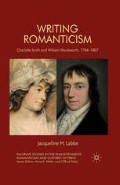Abstract
Both Smith and Wordsworth are identified with specific landscapes: the South Downs in Sussex, the Lake District in Cumbria. While Wordsworth has had the advantage of more than a century’s worth of embedding and iconicizing, Smith is on the verge of becoming a more visible feature in her home landscape, and of course her sonnets set in and around her childhood home, as well as “Beachy Head,” perform the function of creating landscapes, inspiring and enabling the speaker’s verse, among other things.1 Within Romanticism, place often functions as the originary home, the childhood setting, the progenitor of memory which itself informs Romantic poetry; it underpins critical understanding of much of Wordsworth. For both poets, place offers the creation of locality, which in turn leads to a kind of anchoring within the landscape, so that self (or perhaps selves) can be derived from landscape, and hence naturalized: Wordsworth in the Lakes, Smith on the Downs. A kind of place-identity, or place-identification, can be attached to both poets, encouraged by the frequent return to place(s) in their poetry, and their memorializing of rivers, stones, flowers, animals, and diverse locations. This immersion in locale, however, is not without its problems, and both Smith and Wordsworth write into some of their locale poetry a distinct unease, which often corresponds to a speaker’s inability to see past place, or to recognize the relation of this place to that one.
But near one ancient tree, whose wreathed roots
Form’d a rude couch, love-songs and scatter’d rhymes,
Unfinished sentences, or half erased,
And rhapsodies … were sometimes found —
Smith, “Beachy Head,” 1807
— Nay, Traveller! rest.
Wordsworth, “Yew-Tree,” 1798
Access this chapter
Tax calculation will be finalised at checkout
Purchases are for personal use only
Preview
Unable to display preview. Download preview PDF.
Notes
‘Wordsworth, Inscriptions and Romantic Nature Poetry,” ed. Geoffrey Hartman, Beyond Formalism: Literary Essays 1958–1970 (New Haven: Yale University Press, 1970), p. 222.
See, for instance, Judith Pascoe, Romantic Theatricality: Gender, Poetry and Spectatorship (Ithaca: Cornell University Press, 1997); Celeste Langan, Romantic Vagrancy: Wordsworth and the Simulation of Freedom (Cambridge: Cambridge University Press, 1995); Anne Wallace, Walking, Literature and English Culture: the Origins and Uses of Peripatetic in the Nineteenth Century (Oxford: Clarendon Press, 1993); and Robin Jarvis, Romantic Writing and Pedestrian Travel (Basingstoke: Macmillan, 1997).
See “Wordsworth and the Naming of Places,” Essays in Criticism 39 (1983): pp. 196–216, p. 198.
See “Place Deixis and the Schematics of Imagined Space: Milton to Keats,” Poetics Today 26 (2005): 386–432, p. 389.
See also Christoph Bode, “By Way of Introduction: Voice, Text, Mediality — Romantic Self-Positioning,” in Romantic Voices, Romantic Poetics: Selected Papers from the Regensburg Conference of the German Society for English Romanticism (Trier: Wissenschaftlicher Verlag Trier, 2005), pp. 7–20.
See Romantic Geography: Wordsworth and Anglo-European Spaces (Basingstoke: Macmillian, 1998), p. 3.
See Atlas of the European Novel, 1800–1900 (London: Verso, 1998), p. 3.
See Wordsworth Writing (Cambridge: Cambridge University Press, 2007), p. 80.
Timothy Clark makes a similar point when he writes a “text projects or performs its own act of utterance … speaking from out of a non-existent place.” See The Theory of Inspiration: Composition as a Crisis of Subjectivity in Romantic and Post-Romantic Writing (Manchester: Manchester University Press, 1997), p. 23.
“The Critique of Romantic Solipsism in Tennyson’s ‘The Palace of Art,’” The Review of English Studies 57 (2006): 707–20, p. 707.
Christopher Rovee, “Solitude and Sociability: Wordsworth on Helvellyn,” Literature Compass 1 (2004); Beth Lau, “Placing Jane Austen in the Romantic Period: Self and Solitude in the Works of Austen and the Male Romantic Poets,” ERR 15 (2004): 255–67, p. 255.
Clara Tuite and Gillian Russell, eds., Romantic Sociability (Cambridge: Cambridge University Press, 2002), p. 4.
“Communal Romanticism,” ERR 15 (2004): 329–34, pp. 329–30. Cox presents this formulation as that current when he “was taught Romanticism” (p. 329).
Revision and Romantic Authorship (Oxford: Oxford University Press, 1996), pp. 2–3.
Godwin’s Political Justice (London: Duckworth, 1986), p. 164.
See Wordsworth’s Great Period Poems: Four Essays (Cambridge: Cambridge University Press, 1986), Chapter 1: “Insight and oversight: reading ‘Tintern Abbey,’” pp. 14–57.
This echo has also been noted Bishop C. Hunt in “Wordsworth and Charlotte Smith,” The Wordsworth Circle 1 (1970): 85–103; and Kari Lokke in “Charlotte Smith and Literary History: ‘Dark Forgetfulness’ and the ‘Intercession of St. Monica,’” Women’s Studies 27.3 (1998): 259–80. However, neither has noted the significance of the time span.
Copyright information
© 2011 Jacqueline M. Labbe
About this chapter
Cite this chapter
Labbe, J.M. (2011). Subject to Place, Subjected by Poetry. In: Writing Romanticism. Palgrave Studies in the Enlightenment, Romanticism and Cultures of Print. Palgrave Macmillan, London. https://doi.org/10.1057/9780230306141_4
Download citation
DOI: https://doi.org/10.1057/9780230306141_4
Publisher Name: Palgrave Macmillan, London
Print ISBN: 978-1-349-33064-5
Online ISBN: 978-0-230-30614-1
eBook Packages: Palgrave Literature CollectionLiterature, Cultural and Media Studies (R0)

